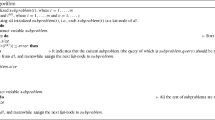Abstract
Linear rankSVM is one of the widely used methods for learning to rank. The existing methods such as trust region Newton method (TRON) with order-statistic tree cannot perform efficiently when any one of them is exploited to deal with the large-scale data sets. It is observed that training the linear rankSVM with L2-loss requires a large amount of data-intensive computing, and therefore is feasible to make use of the great computational power of GPU to improve the training speed. In this paper, we propose two efficient parallel algorithms (named PSWX-TRON and PSY-TRON) to train the linear rankSVM with L2-loss on the GPU architecture. The proposed parallel algorithms can work efficiently on GPU if the training set is divided in terms of different queries. The experimental results show that compared with the existing methods, the proposed algorithms not only can obtain the impressive training speeds, but also can perform well in prediction.








Similar content being viewed by others
Notes
References
Airola A, Pahikkala T, Salakoski T (2011) Training linear ranking svms in linearithmic time using red-black trees. Pattern Recogn Lett 32(9):1328–1336
Burges C, Shaked T, Renshaw E, Lazier A, Deeds M, Hamilton N, Hullender G (2005) Learning to rank using gradient descent. In: Proceedings of the 22nd international conference on Machine learning, ACM, pp 89–96
Cederman D, Tsigas P (2008) A practical quicksort algorithm for graphics processors. In: Proceedings of the 16th Annual European Symposium on Algorithms (ESA 2008), Springer, pp 246–258
Chapelle O, Chang Y (2011) Yahoo! learning to rank challenge overview. J Mach Learn Res Proc Track 14:1–24
Chapelle O, Keerthi SS (2010) Efficient algorithms for ranking with svms. Inf Retr 13(3):201–215
Conn AR, Gould NI, Toint PL (2000) Trust region methods. SIAM, philadelphia
Cooper WS, Gey FC, Dabney DP (1992) Probabilistic retrieval based on staged logistic regression. In: Proceedings of the 15th annual international ACM SIGIR conference on Research and development in information retrieval, ACM, pp 198–210
Cortes C, Vapnik V (1995) Support-vector networks. Mach Learn 20(3):273–297
Fan RE, Chang KW, Hsieh CJ, Wang XR, Lin CJ (2008) Liblinear: a library for large linear classification. J Mach Learn Res 9:1871–1874
Freund Y, Iyer R, Schapire RE, Singer Y (2003) An efficient boosting algorithm for combining preferences. J Mach Learn Res 4:933–969
Fuhr N (1989) Optimum polynomial retrieval functions based on the probability ranking principle. ACM Trans Inf Syst (TOIS) 7(3):183–204
Govindaraju NK, Raghuvanshi N, Henson M, Manocha D (2005) A cache-efficient sorting algorithm for database and data mining computations using graphics processors. University of North Carolina, Technical Report. http://gamma.cs.unc.edu/SORT/gpusort.pdf
Järvelin K, Kekäläinen J (2002) Cumulated gain-based evaluation of ir techniques. ACM Trans Inf Syst (TOIS) 20(4):422–446
Jin J, Lin X (2014) Efficient parallel algorithms for linear rankSVM on gpu. In: Proceedings of the 11 th IFIP WG 10.3 international conference on Network and parallel computing, Springer, pp 181–194
Joachims T (2002) Optimizing search engines using clickthrough data. In: Proceedings of the eighth ACM SIGKDD international conference on Knowledge discovery and data mining, ACM, pp 133–142
Joachims T, Finley T, Yu CNJ (2009) Cutting-plane training of structural svms. Mach Learn 77(1): 27–59
Kuo TM, Lee CP, Lin CJ (2014) Large-scale kernel rankSVM. In: Proceedings of the 2014 society for industrial and applied mathematics (SIAM) international conference on data mining, SIMA, pp 812–820
Lee CP, Lin CJ (2014) Large-scale linear ranksvm. Neural Comput pp 26(4):781–817
Lin CJ, Weng RC, Keerthi SS (2008) Trust region newton method for logistic regression. J Mach Learn Res 9:627–650
Merrill D, Grimshaw A (2011) High performance and scalable radix sorting: a case study of implementing dynamic parallelism for gpu computing. Parallel Process Lett 21(02):245–272
NVIDA CUDA (2007) Compute unified device architecture programming guide. NVIDIA, Santa Clara, CA
NVIDA CUDA (2007) Cublas library programming guide, 1st edn. NVIDA Corporation. http://docs.nvidia.com/cuda/cublas
NVIDA CUDA (2008) CUDA programming guide 2.1. NVIDIA Corporation. http://www.umiacs.umd.edu/~ramani/cmsc828e_gpusci/CUDA21.pdf
Owens JD, Houston M, Luebke D, Green S, Stone JE, Phillips JC (2008) Gpu computing. Proc IEEE 96(5):879–899
Richardson M, Prakash A, Brill E (2006) Beyond pagerank: machine learning for static ranking. In: Proceedings of the 15th international conference on World Wide Web, ACM, pp 707–715
Sculley D (2009) Large scale learning to rank. In: Proceedings of the neural information processing systems 2009 workshop on advances in ranking, pp 1–6
Steinkraus D, Buck I, Simard P (2005) Using gpus for machine learning algorithms. In: Document analysis and recognition, proceedings of 8th international conference on, IEEE, pp 1115–1120
Valizadegan H, Jin R, Zhang R, Mao J (2009) Learning to rank by optimizing ndcg measure. In: Advances in neural information processing systems 22 (NIPS 2009), Curran Associates Inc., pp 1833–1891
Wu Q, Burges CJ, Svore KM, Gao J (2008) Ranking, boosting, and model adaptation. Microsoft Research Technical Report, MSR-TR-2008-109. http://research.microsoft.com/pubs/69536/tr-2008-109.pdf
Yu H, Kim Y, Hwang S (2009) Rv-svm: an efficient method for learning ranking svm. In: Proceedings of the 13 th Pacific-Asia knowledge discovery and data mining conference (PAKDD 2009), Springer, pp 426–438
Acknowledgments
This research is supported in part by the National Natural Science Foundation of China under Grants No. 61472454, and the Project of Department of Education of Guangdong Province under Grants No. 2013KJCX0128. The authors thank the anonymous reviewers for their useful comments and suggestions.
Author information
Authors and Affiliations
Corresponding author
Rights and permissions
About this article
Cite this article
Jin, J., Cai, X., Lai, G. et al. GPU-accelerated parallel algorithms for linear rankSVM. J Supercomput 71, 4141–4171 (2015). https://doi.org/10.1007/s11227-015-1509-6
Published:
Issue Date:
DOI: https://doi.org/10.1007/s11227-015-1509-6




